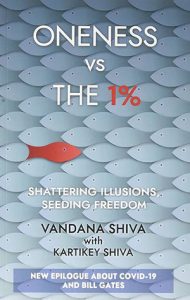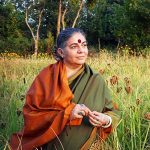Oneness vs the 1%: Shattering Illusions, Seeding Freedom

Author: Vandana Shiva with Kartikey Shiva
Publisher: Chelsea Green Publishing
Year of Publication: 2020
Print Length: 208 pages
Genre: Non-Fiction / Philosophy, Social Science
Topic: Capitalism, Environmental Justice, Social Justice, Conflict, Consumerism & Entertainment, Culture & Society, Nature, Ecology & Climate, Equality & Inequality, Hunger & Starvation, Poverty, Politics & Power, Solidarity
With a new epilogue about Bill Gates’s global agenda and how we can resist the billionaires’ war on life.
“This is what globalization looks like: Opportunism. Exploitation. Further centralization of power. Further disempowerment of ordinary people. . . . Vandana Shiva is an expert whose analysis has helped us understand this situation much more deeply.”―Russell Brand
Widespread poverty, social unrest, and economic polarization have become our lived reality as the top 1% of the world’s seven-billion-plus population pushes the planet―and all its people―to the social and ecological brink.
In Oneness vs. the 1%, Vandana Shiva takes on the billionaire dictators of Gates, Buffet, and Mark Zuckerberg, as well as other modern empires like Big Tech, Big Pharma, and Big Ag, whose blindness to the rights of people, and to the destructive impact of their construct of linear progress, have wrought havoc across the world. Their single-minded pursuit of profit has undemocratically enforced uniformity and monocultures, division and separation, monopolies and external control―over finance, food, energy, information, healthcare, and even relationships.
Basing her analysis on explosive facts, Shiva exposes the 1%’s model of philanthrocapitalism, which is about deploying unaccountable money to bypass democratic structures, derail diversity, and impose totalitarian ideas based on One Science, One Agriculture, and One History. Instead, Shiva calls for the resurgence of:
Real knowledge
Real intelligence
Real wealth
Real work
Real well-being
With these core goals, people can reclaim their right to: Live Free. Think Free. Breathe Free. Eat Free.
Table of Contents
Preface
1. 1% vs ONE EARTH, ONE HUMANITY
Diversity and our interconnected freedoms
Life is self-organised, life is intelligent
The ecology and economics of interconnectedness
We are one earth family, we are interbeings
The empire of the 1% separation, violence, colonisation, extractivism, extinction
Separation, the mechanical mind and mechanical intelligence
2. THE MONEY MACHINE OF THE 1%
How the billionaires make money out of money, while controlling our real worlds and our lives
Gambling in the global casino while appropriating the wealth of people: the story of Buffett
Vanguard and the new armada of investment funds: how the 1% control the economy and giant corporations
3. THE TECHNOLOGY MACHINE OF THE 1%
How the robber barons and the toxic cartel poisoned our daily bread and the planet
Genetic determinism, genetic reductionism and genetic engineering
Peddling poisons and scientific fraud, stealing lives
Climate change, big data and digital agriculture: the future of agriculture according to the 1%
The new robber barons and their digital empires
The vision of one agriculture, one science, one monoculture, one monopoly
Golden Rice: a blind approach to preventing blindness is not science
Gates and his expanding patent empire
Bill Gates, biodiversity, gene drives and new GMOs: from the terminator to the exterminator
Financialisation, patentisation and forced digitisation
Philanthrocapitalism
One History: an illusion constructed by the 1%
The Gates story of the 1% is not a universal story
Toxic Cartel Shareholders
4. HOW THE 1% SUBVERTS DEMOCRACY
Swaraj — the resurgence of real freedom for all beings
Swadeshi — the resurgence of real wealth, real work and wellbeing
Satyagraha — the resurgence of real resistance, real democracy
Seeding the future, seeding freedom through earth democracy
EPILOGUE
Endnotes
Index

Vandana Shiva is an Indian physicist and social activist. Shiva founded the Research Foundation for Science, Technology, and Natural Resource Policy (RFSTN), an organization devoted to developing sustainable methods of agriculture and established seed banks throughout India to preserve the country’s agricultural heritage, in 1982. Shiva developed an interest in environmentalism during a visit home from Canada, where she discovered that a favourite childhood forest had been cleared and a stream drained so that an apple orchard could be planted. She was perhaps best known as a critic of Asia’s Green Revolution, an international effort that began in the 1960s to increase food production in less-developed countries through higher-yielding seed stocks and the increased use of pesticides and fertilizers. The Green Revolution, she maintained, had led to pollution, a loss of indigenous seed diversity and traditional agricultural knowledge, and the troubling dependence of poor farmers on costly chemicals.
Source: https://www.britannica.com/biography/Vandana-Shiva
More from Vandana Shiva in this library, click here.
